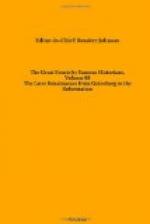Most wonderful of all, perhaps, is the improved printing-press itself, in various classes, each adapted to its special purpose. The sum of all improvements in this department of mechanical invention is seen in the great cylinder-presses now in general use, especially the one known as the web perfecting press. This is a machine of great size and intricate construction, which yet does its complex work with an accuracy that almost seems to denote conscious intelligence. It prints from an immense roll of paper, making the impression from curved stereotype plates, runs at high speed, prints both sides of the paper at one run, and folds, pastes, and performs other processes as provided for. By doubling and quadrupling the parts, the ordinary speed of about twenty-four thousand impressions an hour may be increased to one hundred thousand an hour. The multicolor web perfecting press prints four or more colors at one revolution of the impression cylinder.
To meet the demands of such an enormous consumption of paper as the modern press requires, it was necessary to invent other processes and to utilize more abundant and cheaper material for paper-making than those formerly employed. This requirement has been supplied in recent years mainly through the extensive manufacture of paper from wood-pulp. This method, together with improved processes in the use of other materials, has removed all fear of a paper famine such as has sometimes threatened the printing industry in the past.
“Nature does not advance by leaps,” says an old proverb; neither does her offspring, Art. All the great boons vouchsafed to man by a munificent providence are of gradual development; and though some may appear to have come upon us suddenly, reflection and inquiry will always show that they have had their previous stages.
Indeed, nothing in this great world which concerns the well-being of man takes place by accident, but is brought forward by divine will, precisely at the moment most suitable to our condition. So it was with astronomy, the mariner’s compass, the steam-engine, gas, the electric telegraph, and many other of those blessings which have progressed with civilization. The elements were there and known, but the time had not arrived for their fructification.
And so it is with printing: although its invention is placed in the middle of the fifteenth century, and almost the very year fixed, this can only be regarded as a matured stage of it. To illustrate this, I propose to begin with a cursory view of its primitive elements, of which the very first were no doubt initiative marks and numerals.
The use of numerals has been denominated “the foundation of all the arts of life”; and we know with certainty that several nations, and among them the Mexicans, had numerals before they were acquainted with letters. The first method of reckoning was with the fingers, but small stones were also used—hence the words “calculate” and “calculation,” which are derived from calculus, the Latin for a pebble-stone.




